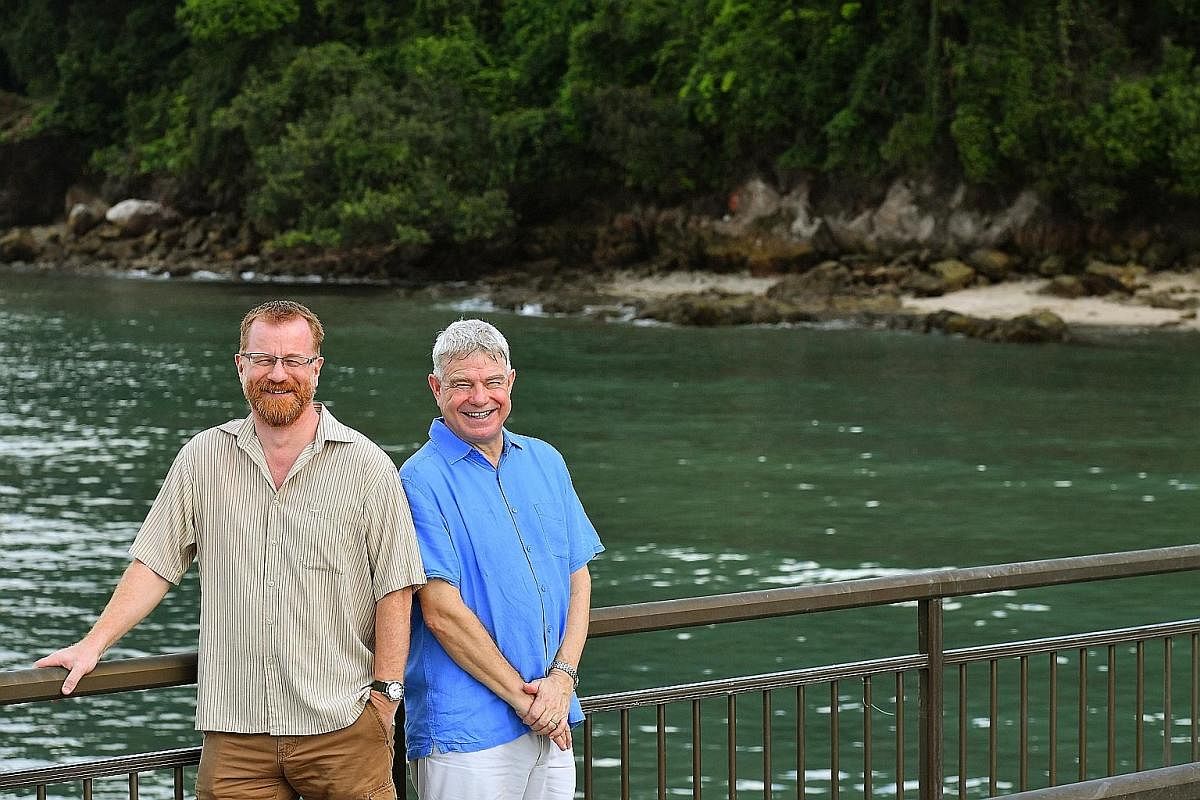Don't give rocky shores a wide berth
Studies of such habitats can show impact of climate change

Singapore may wear a concrete crown but it has a necklace of greens and blues along its coast.
Some of the natural habitats, like coral reefs and sandy beaches, are generally well studied.
But the same cannot be said for rocky shores, which can be found in places such as the Labrador Nature Reserve and Pulau Ubin.
But last month, Professor Stephen Hawkins, an expert on rocky shores from the University of Southampton in Britain, was in Singapore to speak about these habitats, in hopes of spurring greater scientific interest in them.
Formed when waves erode rocks along the shore, rocky shores are a landscape of bedrock platforms and large boulders dotted with nooks and crannies where critters such as crabs like to hide.
The rocks also provide a good substrate for barnacles and mussels to latch on to.
Such habitats make up between 60 and 70 per cent of the world's coastal areas, said Prof Hawkins, who was in town under the National University of Singapore (NUS) Society Professorship programme.
However, though rocky shores are widely studied in temperate regions, there is scant data on them and how they function in the tropics, he added.
This is not surprising, considering the multitude of other marine habitats in this part of the world, said Prof Hawkins.
The great diversity and "nice and warm" waters here make the study of other habitats such as coral reefs and mangroves attractive options, he said.
But up north, where waters are cold, researchers like Prof Hawkins prefer to stay on land instead.
For him, rocky shore habitats were a good compromise between land and sea.
"I love them, they are so beautiful and diverse, with plenty of seaweeds, barnacles and mussels," said Prof Hawkins, who was the former director of the Plymouth Laboratory of the Marine Biological Association of the United Kingdom.
But other than being treasure troves of marine biodiversity, rocky shore habitats can also be useful indicators of climate change - increasingly erratic weather caused by heat-trapping greenhouse gases emitted by human activity.
Prof Hawkins' work in Plymouth in south-western England has already demonstrated this.
Using seawater temperature data that goes back to the 1870s, he found that as sea surface temperature fluctuates, so does the composition of barnacle species on the rocky shores. The shores have been studied since the 1950s.
Britain undergoes cycles of warmer and cooler weather.
In the 1950s, for example, Britain experienced warming sea-surface temperatures, which corresponded with increasing numbers of the Chthamalus species - barnacles that thrive in warm water.
There was a cooler period between the 1960s and the 1980s, when there was a resurgence of another barnacle species, Semibalanus, also called the northern species of barnacles.
These cyclical patterns appear throughout the 60-year data set.
However, Prof Hawkins noted that warming from 1988 till 2014 has increased at a rate much faster than before, leading to a proliferation of the warm-water Chthamalus.
"My initial thought was that it was a typical fluctuation of the cycle, but then the rate of warming was much faster, and sea-surface temperatures are also warmer than before," he said.
Sea-surface temperatures had fluctuated between 12.5 deg C and about 13 deg C since the 1870s.
However, they hit a high of 13.7 deg C around 2010, Prof Hawkins noted.
If the trend continues, this may eventually result in dwindling numbers of the more productive northern species of barnacles.
These barnacles grow densely and as a consequence they form a good place for the early stages of seaweeds to grow.
These species of seaweeds are also northern and thrive in cold water, and will do less well in a warmer world.
Seaweeds are primary producers and form the base of the food chain in rocky shore habitats.
Tropical rocky shores can be a useful indicator of climate change, he said.
But, first, long-term data on the habitat is needed.
The good news is that researchers under Associate Professor Peter Todd, from the NUS Science Faculty's Biological Sciences Department, are embarking on projects to learn more about these habitats.
One research project involves the monitoring of a few rocky shore sites on Singapore's southern islands to look for the effects of climate change.
Researchers have created a list of about 50 easily identifiable species to track over time .
Examples include certain species of top shells, barnacles and brown algae known as sargassum.
"Using well-known species and keeping the methodology relatively simple will help ensure the long-term success of sustained observation as it is expected that different people will conduct the work over the years," said Prof Todd.
The methodology would most likely include processes such as quadrat sampling, which will see scientists searching for the organisms within a fixed area, as well as taking high-quality photographs and notes on the features of the site.
NUS Professor Leo Tan noted that Singapore has few rocky shores to begin with.
As these were ideal for industrialisation and shore reclamation works, they disappeared relatively quickly before detailed studies could be carried out, he said.
He spent 40 years fighting for the preservation of Labrador Park, which has rocky shore habitats, and succeeded in 2002, when it was gazetted a nature reserve.
Prof Todd said: "If we are to learn how to better manage these ecosystems, we first need to know what is there."
Join ST's WhatsApp Channel and get the latest news and must-reads.
A version of this article appeared in the print edition of The Straits Times on February 10, 2017, with the headline Don't give rocky shores a wide berth. Subscribe

